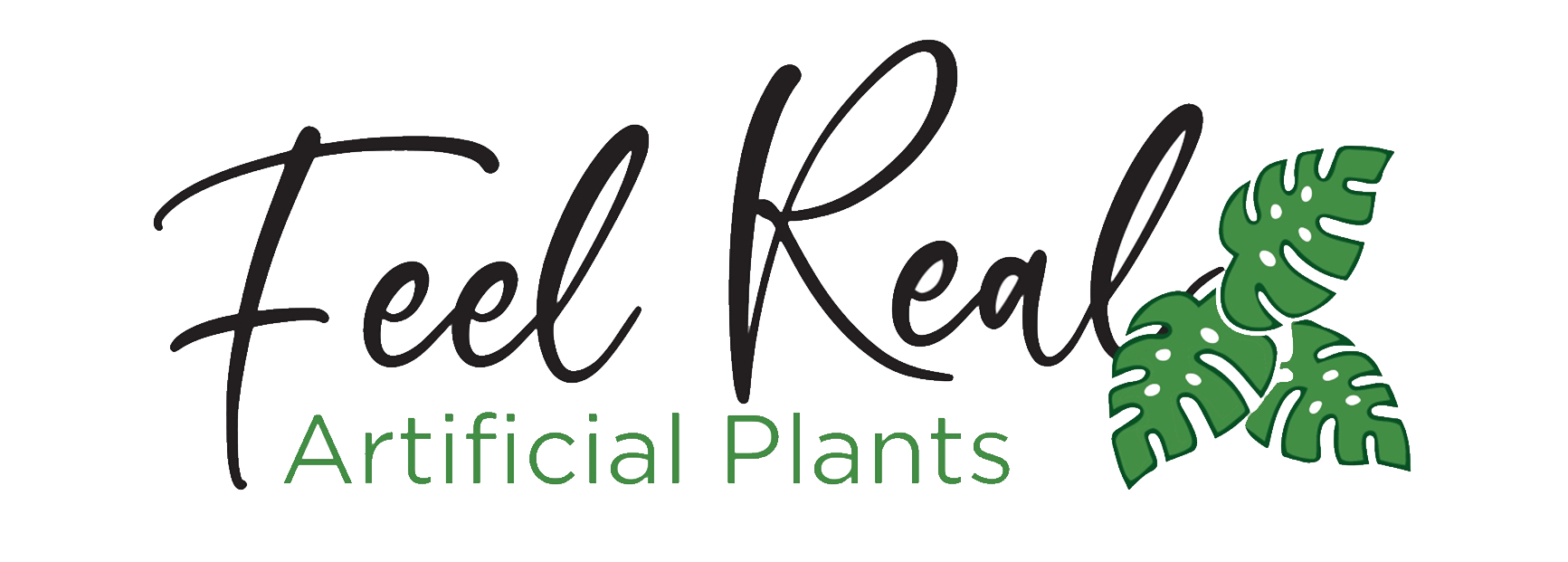Artificial plants have found their way into city apartments and family homes in the suburbs, and have become the preferred solution to the need to add beauty, greenery, and luxury to both indoor and outdoor spaces. However, not all artificial plants are safe when it comes to protecting curious children and pets that love to play with things. Artificial plants can take your home design into the next level of realism, and what is more, the wrong ones may pose certain risks.
If you are preparing your nursery with soft silk succulents or want to find some durable hanging baskets in your patio, there are a few things to consider when you want to create a safe and stylish place where your whole family will enjoy. Now, without further ado, let us explore everything there is to know about choosing the best artificial plants that are safe around kids and pets, as per the professionals.
Are Artificial Plants Safe for Kids and Pets?
Fake plants have emerged as a staple of interior design in houses, office, and even in the outdoors such as balconies and patios. In the case of families with children and pets, however, priority goes to safety. With the right artificial plants, you can attain the appearance of a green paradise without fearing the dangers that await your loved ones.
On the same note, cats and dogs can bite the leaves or dig up planters. Whether it is toddlers crawling on the floor or kids touching every part of your house, a badly made fake plant can be a potential choking hazard. The new artificial plants are especially pet and child friendly, especially when they are made using safe plastics (like polyethylene (PE) or silk). That is why it is necessary to work with non-toxic, stable materials with no detachable parts.
Contrary to that, the modern faux plants, particularly those created with safe plastics such as polymer (PE) or silk, are intended to be safe around pets and children. The best ones are those that do not have sharp stems or those whose coatings are well treated. Moreover, they can be located in the places with high traffic such as living rooms, playrooms, or grass nurseries.
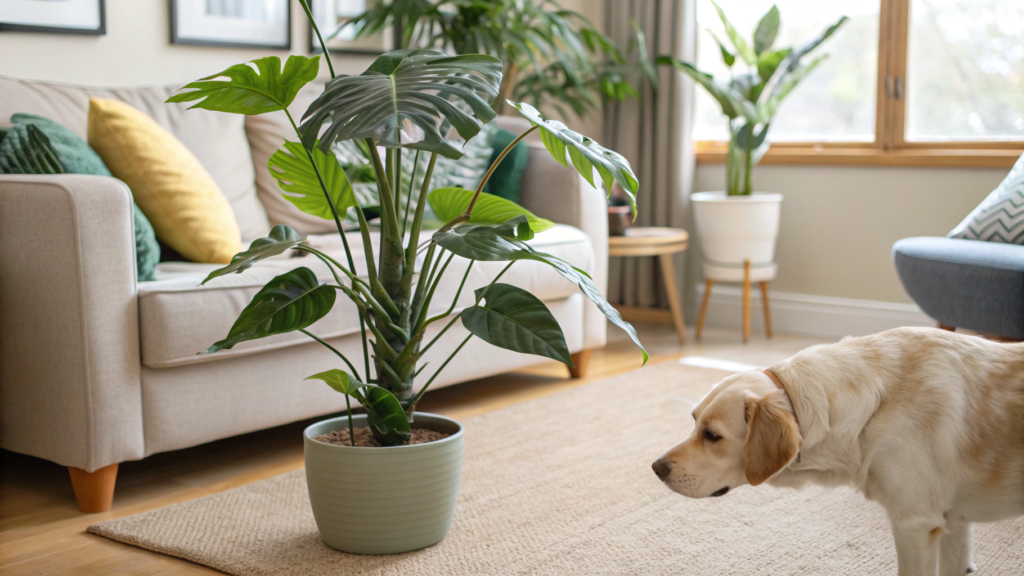
Modern artificial plants are not only decorative but also engineered for real-life safety and durability. At FeelReal, we use non-toxic, certified materials like polyethylene (PE) and silk blends, which have passed third-party safety tests and are resistant to fading, tearing, and shedding. Many of our clients—including daycare centers, pediatric clinics, and pet-friendly cafés—have successfully incorporated our faux greenery into high-touch environments without safety concerns.
The Toxic Ten: Materials and Chemicals to Avoid in Faux Plants
Before you use your home as a garden, you should understand that not every fake plant is safe to use. Here are ten of the most prevalent harmful ingredients in synthetic plants and why they should be in your line of sight when shopping child and pet-friendly varieties.
Harmful Heavy Metals in Fake Plants
Although artificial plants might seem harmless, some of the materials used in cheaper ones can be plainly hazardous. Other fake plants contain toxic heavy metals which are very harmful to children and pets.
- Lead: Some of the worst quality artificial plants contain pigments, stabilizers and artificial fillers that are made of lead. Even small quantities may damage neurological development of a child after repeated exposure or accidental consumption.The use of products with lead, which are not approved as being safe, must be avoided.
- Mercury: It is not that common but it may be used on dyes or imaging. It is so toxic that it can lead to neurological damage to the brain, particularly that of developing brains.
- Cadmium: This one is used to achieve a deep colouring of plastic flowers and leaves, mostly in orange and red. It is connected with lung and kidney injuries, and even cancer. Unluckily, cadmium tends to appear in the non-regulated imitation plants.
To avoid these pitfalls, it is always safer to buy artificial plants that have been tested by third parties and are safe, such as RoHS or REACH. Such certifications restrict or prohibit heavy metals in consumer products, so your fake ficus or fig trees will be much safer to all back at home.
Harmful Chemicals in Artificial Plants
Besides metals, synthetic plants have the potential to release toxic chemicals in the long run. Low-quality materials can off-gas and reduce the quality of the indoor air and themselves continuously present a danger to your pets and family.
- Volatile Organic Compounds (VOCs) are chemicals that evaporate and turn into gases from products such as adhesives, flame retardant. There is also a risk of headaches, nausea, and respiratory problems when exposed to it over long periods of time.
- Formaldehyde is a form of adhesive and resin chemical. It is known to be a carcinogen and irritates the lungs, especially in kids and in pets like cats and dogs.
- Some plastics have Brominated Flame Retardants (BFRs) added to them so that the plastics will be fire-resistant. Nevertheless, BFRs are associated with the disruption of hormones and infertility.
- Phthalates are added to plastic to ensure flexibility in plastics and the stems. Sadly, they are also related to developmental and reproductive issues.
- Another category of cancer-causing agents is Polycyclic Aromatic Hydrocarbons (PAHs) which are mostly found in synthetic dyes.
- Bisphenol A (BPA) is a known chemical in plastics that imitates hormones in our body. BPA-free fake plants are the must have for pet and child safe homes.
- Some of the treatments that are used to maintain the appearance and feel of plants can release Chlorine Compounds. These compounds will release gas that is able to induce respiratory distress when exposed to heat.
The first thing to do in order to avoid these chemicals is to choose plants that are provided by a trust-worthy company that openly discloses the results of tests, safety approvals, and sources of materials. Do not be afraid to demand comprehensive safety record of a manufacturer.
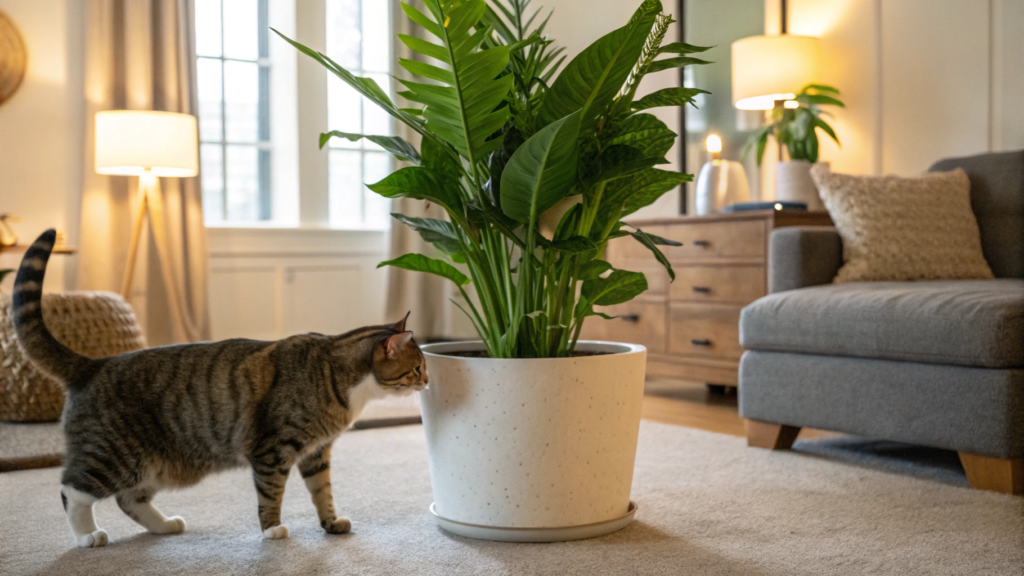
The Safe Five: Quality Standards for Non-Toxic Fake Plants
To help you make an informed decision on purchasing artificial plants that are safe to use around children and pets, we are going to explain six standards and certifications that make up a real quality and non-toxicity. These standards make sure that your lavender greenery does not not only look good but also remains safe to use in your everyday residential conditions.
Regulatory Compliance for Artificial Plants
Regulatory compliance is one of the most valuable aspects to consider when it comes to the safety of artificial plants used in family homes. Informed consumers realise that certification does not only identify the quality of the product but assures that the product ingredients are of high environmental and health standards. Such certifications are especially useful when choosing synthetic plants in areas that children and pets have access to as it helps decrease exposure to harmful chemicals that are not necessarily visible to the naked eye. These include:
- RoHS (Restriction of Hazardous Substances): RoHS certification provides assurance that a product has been tested and found to contain levels below the legal limit for ten specific materials. This includes toxic heavy metals like lead (Pb), cadmium (Cd), and mercury (Hg), which are particularly harmful to neurological development and overall health. For a household with children and pets, this certification is a critical indicator of safety, ensuring the artificial greenery does not pose a risk of toxic exposure through touch or accidental ingestion.
- REACH (Registration, Evaluation, Authorisation, and Restriction of Chemicals): REACH is another EU regulation that covers the entire lifecycle of the chemicals contained in a product all the way through to manufacturing, distribution and sourcing. An artificial plant, which is REACH-compliant, ensures that the manufacturer has assessed the effects of all the chemical ingredients and eliminated or minimized substances of very high concern. It promotes transparency in supply chains as well, to enable consumers to find out where and how their artificial greenery is manufactured. This kind of transparency is also important to eco-sensitive families who are concerned with the utilization of safe and responsible material in home decor.
Quality Assurance for Artificial Plants
Although regulatory standards such as RoHS and REACH certify a product as compliant with the law, the best manufacturers take this a notch higher by adopting stringent quality assurance processes. These extra levels of checks and tests are reassuring, especially where faux planting is in pet and child-friendly surroundings.
- Independent Laboratory Testing: Good brands will be tested in the artificial plants at the third party laboratories where the tests will be done in detail. These tests evaluate such things as the composition of the materials, the flammability and the level of VOC off-gassing. Independent lab testing is an essential step in consumer protection by confirming that every product is not only safe to use (it does not contain harmful toxins), but also it can be used in average residential conditions to the full extent. Some reports will be available through request and many manufacturers will do so so go ahead and ask them.
- SGS Certification: SGS is a leading inspection, verification, testing and certifying company in the world. When a product has been certified by SGS one thing you can be assured of is that when the plant is checked it meets the quality, durability and safety standards of a tested global standard. This will entail guaranteeing that the artificial foliage will not fade faster, decompose under the UV rays or release toxic chemicals as time goes by. It is a stamp of originality which denotes a responsible field sourcing and production.
- ISO Certification: ISO (International Organization for Standardization) certification signifies that a manufacturer adheres to rigorous, internationally recognized standards for quality management. This framework ensures consistency and a commitment to continuous improvement across all business processes. For artificial plants, this certification covers the entire lifecycle of the product, from the sourcing of materials to manufacturing and final inspection. Choosing a product from an ISO-certified company provides an added layer of assurance that you are buying from a reliable manufacturer dedicated to producing safe, durable, and consistently high-quality faux greenery.
True quality assurance goes beyond certifications—it’s about how products perform in the hands of real customers. At FeelReal, we’ve built our QA protocols around both international standards and years of factory experience.We pull on leaves to ensure they are securely fastened and won’t become choking hazards, and we check that support wires don’t poke through the plastic casing after being bent.
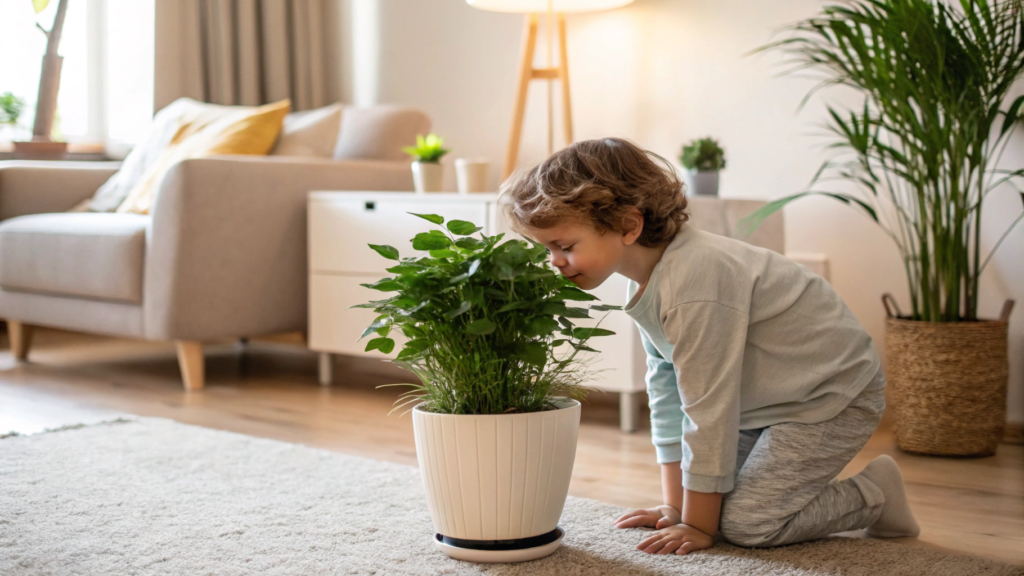
A practical solution for customers is to ask for the documentation; a reputable manufacturer can provide copies of their certifications or test reports upon request. Furthermore, inquire about solutions for common issues. For instance, if you need outdoor plants, ask specifically about the grade of UV protection used, as factories use different levels of inhibitors for full-sun versus shaded applications. A truly quality-focused manufacturer will not only possess the certifications but will also be transparent about their construction methods and able to provide clear, verifiable answers to ensure the final product is safe, durable, and fit for your specific needs.
Material Safety in Artificial Plants
Fake plants nowadays are not only prepared to imitate the beauty of real foliage but also to be used in a variety of conditions in a safe way. Be it in residential interior, childcare facility or outdoor, materials and construction of such products is crucial towards long term safety and reliability. The following are three key safety considerations that should be present in artificial plants, all of which are the results of careful material science and engineering design.
- Non-Toxic UV Stabilizers: Artificial plants placed outdoors should be exposed to the sun all the time and this may lead to fading, cracking or deterioration of the material with time. The chemical additives known as non-toxic UV stabilizers are added to the plant materials to screen out the damaging ultraviolet rays by preventing the buildup of toxic residues. The stabilizers help in retention of the color and structure of the artificial foliage even in high-sun regions such as patio, balconies, and rooftop gardens. Notably, current formulations are free of harsh compounds or heavy metals, meaning that they are safer to the environment and any human or animal that may come in contact with the plants.
- Low Off-Gassing Materials: Another health consideration that is not visible in confined spaces especially where air movement is minimal is low-off-gassing materials.Usually high-quality artificial plants would be manufactured using low-emission materials such as polyethylene (PE), ethylene-vinyl acetate (EVA) or special treated silk, all of which are characterized by chemical stability and low emission of volatile organic compounds (VOCs). All these materials are safer to be used in bedrooms, hospitals, schools and offices. Furthermore, they are resistant to warping, cracking, or eventual degradation by chemicals, thereby making them safe and appealing long after the installation.
- Pet and Child-Safe Components: When used in homes, schools and nurseries, artificial plants should be constructed in a way that removes safety risks that are common. Rounded stems, soft-touch materials, securely held leaves are some of the features that aid in reducing the possibility of injury or choking even when pets or children are playing roughly with the plants. The bases of the planters are wide and non-slippery to add physical stability, so the plants that would otherwise tip over and fall are prevented by bumping into them or pulling. Together with non-toxic paints and adhesives, these construction materials of known manufacturers such as FeelReal, make artificial plants a safe solution with no difficulties to use in any place where safety is the priority.
Expert Manufacturer Tips for Selecting Safe Artificial Plants
As a new or veteran artificial greenery user, it may not be easy to pick and place faux plants haphazardly and expect it to work out. The safety, durability and material quality cannot be underestimated especially when there are kids, pets or sensitive persons living in the house. Low-quality synthetic plants may emit toxic chemicals, become choking hazards, or even break or fade away in the sunlight or due to physical stress. This checklist will guide you to make wise decisions about your faux plants by focusing on some of the most important features that make your faux plants not only stylish and realistic but also safe, long-lived, and child-friendly.
Ensure the Plants Are Made from Safe Plastics Like PE or Silk
Any safe artificial plant is based on what the material is made of. Polyethylene (PE) and silk are some of the most well known and the safest and most realistic avenues there are. PE is very tough, and can be easily shaped, it has a great natural appearance of both veining and movement of natural leaves. Although silk is very soft and fragile, it offers a luxurious look that can be used in decoration of the interior of a building.
Notably, the two materials are low in VOCs emission, and they do not contain any toxic additives, which can lead to the harming of children or pets. Never use poor quality plastics that can still contain phthalates, lead or BPA that can be of long term health risks in the residential area.
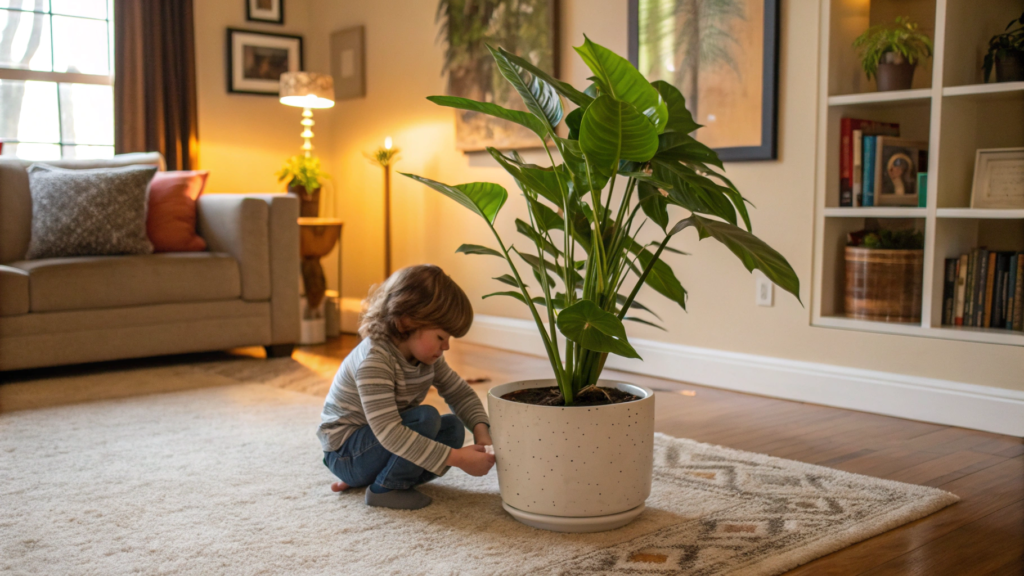
Check for Flame-Retardant Certifications
As much as aesthetics is considered, safety is also a major factor particularly in homes with children and pets. Synthetic plants must be accompanied by tested fire-resistant treatment together with documentation to make sure that it will not be easy to burn in case there is an accident. U.S. and many other countries have some form of third party lab certification like NFPA 701 to ensure the material is ignition resistant, and flame spread is controlled.
This is especially necessary with artificial plants that come close to things that produce heat such as radiators, fireplaces or stoves. Where there is a lot of movement and children or pets around the house like in play rooms or the main living area, flame retardant faux plants are an added measure of safety.
Verify Manufacturer Safety Testing and Certifications
Quality manufacturers are supposed to be in possession of third-party safety testing reports at all times, and should also have recognized certifications. Products ought to conform to standards like RoHS, which limits the use of hazardous materials; REACH, which assesses supply chains of chemical safety; SGS, a quality inspection company with global presence; and ISO, which certifies management systems, quality.

Such certifications are not mere labels, they reflect high levels of testing of toxic chemicals, materials used, and performance of products. After undergoing all these tests, you can be confident of the artificial plants being of the best quality in terms of safety and structural integrity.
At FeelReal, we maintain up-to-date third-party testing reports and certification documentation, not only to meet regulatory requirements but to uphold our responsibility to customers. Our internal teams work closely with accredited labs and continuously refine production processes to meet evolving standards. By combining industry compliance with hands-on manufacturing insight, we ensure our artificial plants meet the highest benchmarks of safety, material quality, and long-term reliability—delivering products our customers can trust in any environment.
Choose Durable Construction Without Sharp Edges
Design that takes into consideration safety is equally crucial as composition of materials. Check the stems, leaves and bottom of each plant just to ensure that it does not have sharp ends and rough areas or poking out wires. These are dangerous in that they may cause cuts or scratches, especially when they are touched by young children and pets that are in close contact with them.
Also, the plants that are highly structural will not bend or break easily with the daily pressure. Select designs that do not lose their shape and form when touched, nudged or even bumped once in a while and still manage to look great and remain safe.
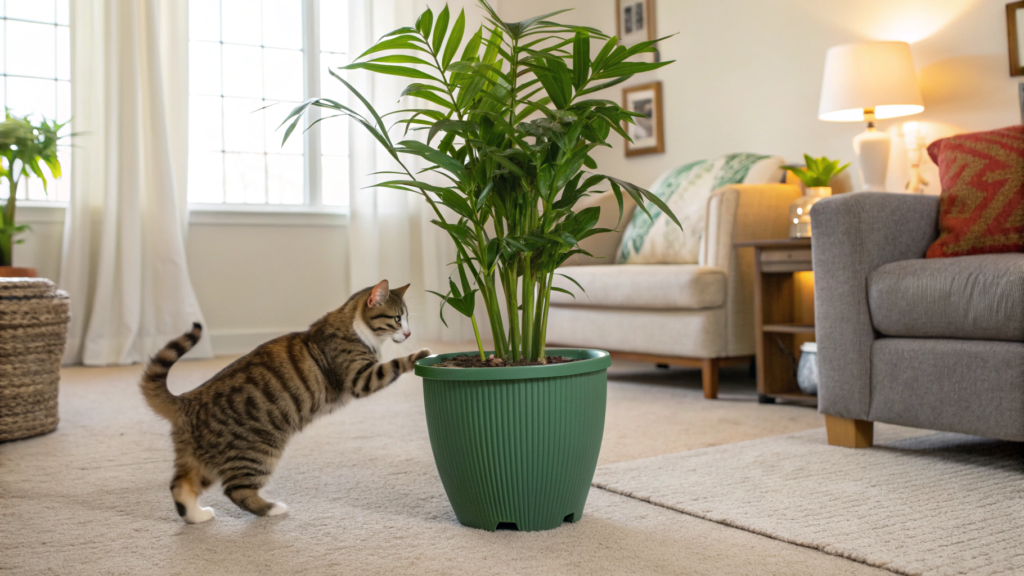
Opt for Stable, Weighted Pots or Bases
Artificial plants that are going to be used in homes with children or pets need a weighted base. It minimizes the chances of it falling over during play or cleaning, and this can lead to injuries or property breakages in the house. Pots that are wide and heavy, or those with inbuilt weights that maximize stability are to be sought.
This quality is particularly significant with tall faux tree such as fiddle leaf fig or palm trees which are kept on the floor, around the doors, or at the reach of children. Choose planters that are crafted out of non-toxic materials that will not break easily with frequent usage and can last long.
Best Types of Safe Plastic Plants for Pet- and Kid-Friendly Homes
No matter what you are decorating, a comfy nursery, a pet-friendly sitting room, or you are just trying to boost the greenery in your home, but you do not want to take the risk, these faux faves are carefully selected so that they are not only pretty, but also safe. They are the best options in a case when there are children, dogs, or curious cats:
Pet-Safe Faux Ferns and Hanging Vines
Faux ferns and hanging vines are soft, with a more naturally elegant droop, which makes them a lovely addition to the indoors or outdoors environment. Baskets on balconies or patios are particularly ideal places to have such fake plants because their trailing plant features create an aesthetic appeal without the need to take care of them.They have bendable stalks, and fluffy greens that are not harmful to pets and small kids.
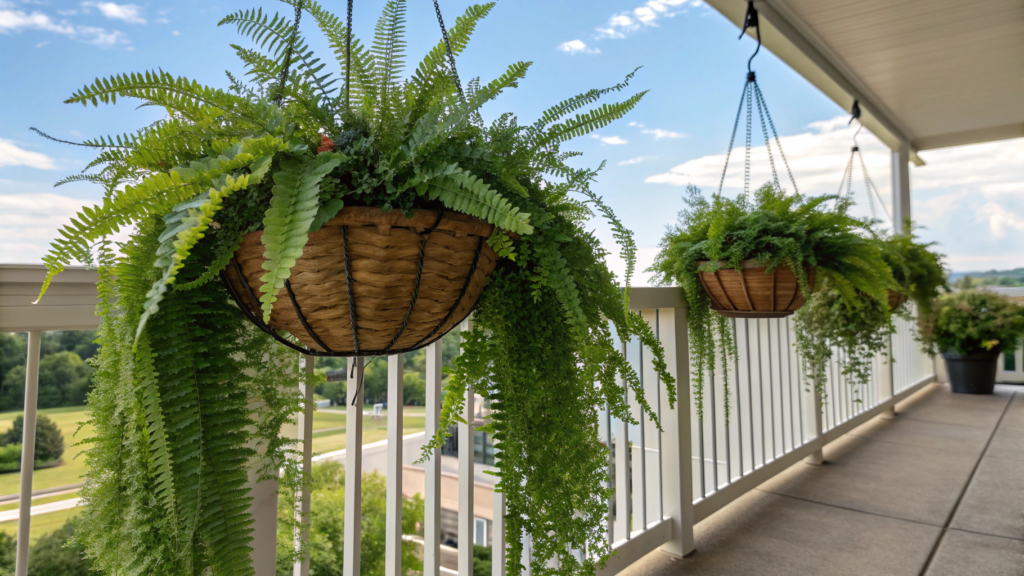
The most prominent feature of faux ferns of high quality is the durability. The majority of them are designed using materials that cannot fade easily when placed under the indirect sun or next to the window. When they are put in wall planters or suspended on ceilings, they form a vertical landscape of green that lifts the general atmosphere of any room without being pet- and kid-unfriendly in any way.
Non-Toxic Artificial Fiddle Leaf Fig Trees
Fiddle leaf fig trees are a current design trend due to the large, statement making leaves and tall, tree like form. Rather than being toxic, faux products made of non-toxic PE or silk give the same bold aesthetic without any safety concerns of pets or children. They are an ideal choice of a living room, a play area or a place of work where style and security meet.
The artificial fig trees with UV protection are particularly excellent to place close to windows or sunrooms that have plenty of light. Their leaves do not crack or even fade with time and they do not tip over since they have their heavy bases. Faux fiddle leaf fig looks amazing and is low maintenance as a centre piece in any big room.
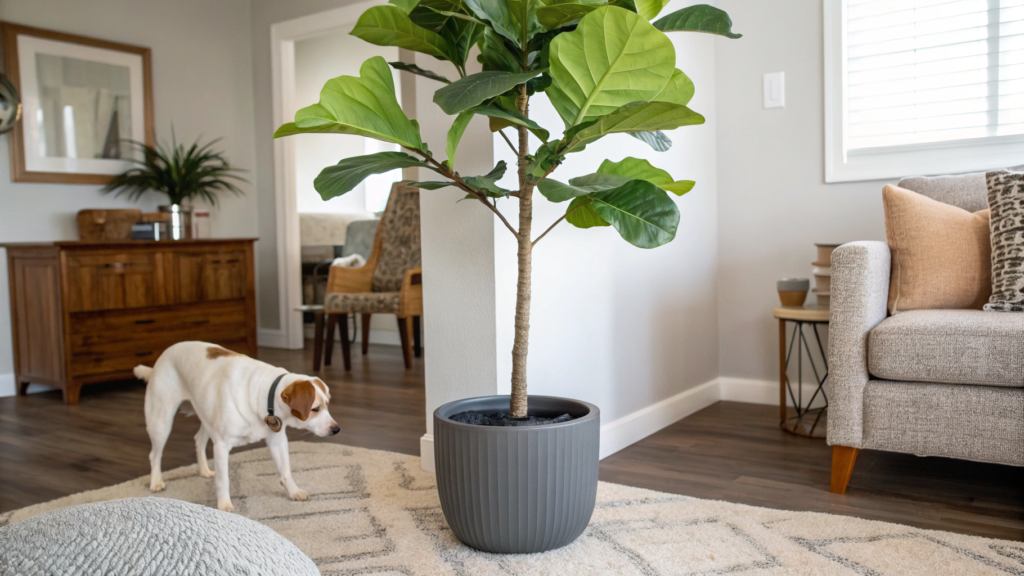
Child-Friendly Potted Succulents
Artificial succulents are small, tough, and cute, making them one of the most common decorations in the tabletops, desks, and shelves. They are good in houses with children as they have soft-touch plastics and small and rounded shape. These plants have no spiky edges or parts to fall off, so they can be taken into your space without any fear of them.
Most of the faux succulents in pots are pre-planted in decorative pots and thus are a perfect fit in terms of centerpieces and small space design. They provide safe, stylish greenery that can be used to spruce up a nursery or sit on a kitchen counter as a filler and they will fit perfectly with your existing decor.
Safe Silk Olive Trees for Elegant Interiors
Artificial olive trees create a high-brow, comforting ambiance in a bedroom, reading table or lounge area with their thin stem and plush appearance of the grey green leaves. Silk types offer the most realistic imitation, having the soft matte texture that can be used as the real one, but this one is not dangerous to children or pets.
Such artificial trees are ideal to bring a high-end, European-style decoration to home decor. Silk foliage is soft, which makes it perfect when you need to interact closely and in places where children can touch. Put one in a window or next to a corner planter, and you will find it adds that much needed touch of sophistication and softness to your surroundings.
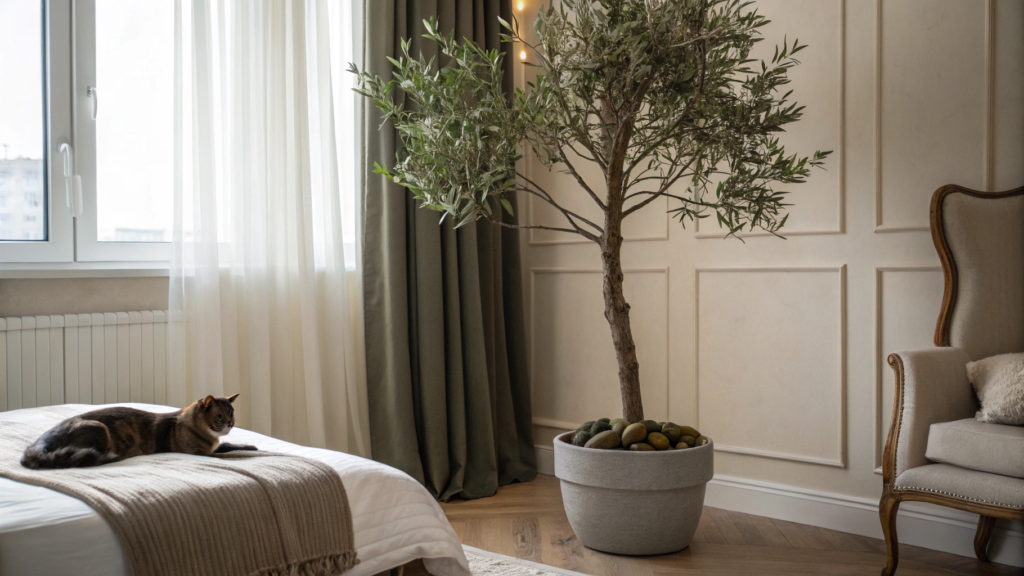
Calming Artificial Bamboo Plants
One of the best options in decoration with the creation of tranquility in any setting is the use of artificial bamboo plants. With their straight stems and rich foliage, they give a sense of tranquility and spa-well being that can be used to balance out both the minimalist living rooms and the colorful entryways. Fake bamboo is robustly made, so it will withstand the weight of everyday activities of pet-friendly and kid-friendly households.
There are a number of superior quality bamboo products that are synthetically made without any toxins and also durable. These tall artificial plants are great to use on the floor and in larger container where its narrow shape can give height and base without dominating the room.
UV-Coated Palm Plants for Outdoor Patios
No fake palm tree can yell vacation in the tropics like an artificial palm tree and the UV treated ones are made to take the sun, wind and rain and not fade. UV-treated Kentia and other palm species perform well in exterior environments such as on patios, balconies or even the pool area. Their fronds are big, bendable, and will not be dangerous to households with young pets or toddlers.
These fake palm trees are usually in large, sturdy planters, and thus they are an ideal solution to add some interest in a corner of your outdoor space or to decorate a seating area. They are deep in color and very life-like to the touch, and can take the outdoor elements with ease, and give your space a bit of island flavor all year round.
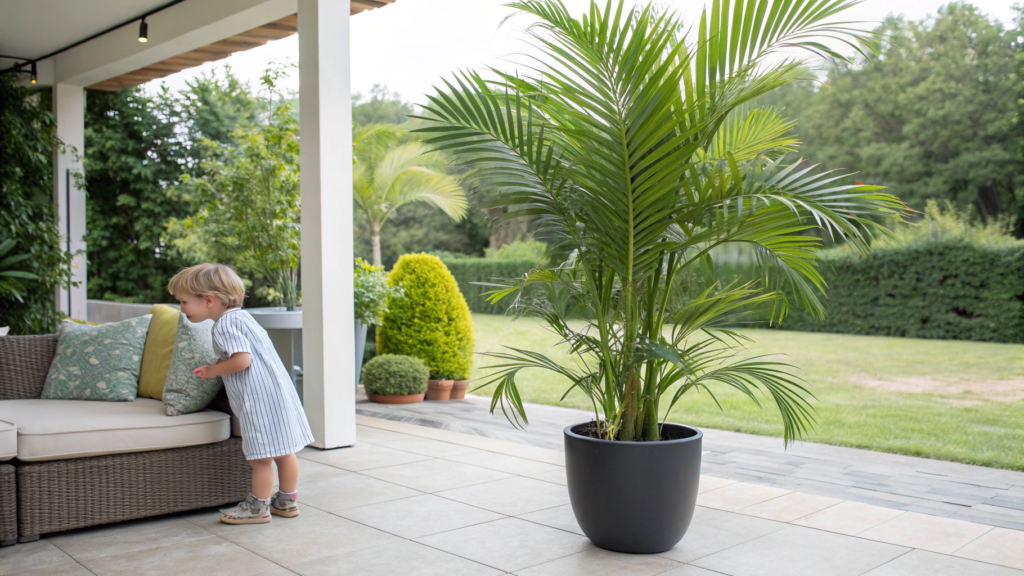
FAQs about Safe Artificial Plants
1. How to Clean and Maintain Artificial Plants Safely?
Dusting of artificial plants should be done using a microfiber cloth and this should be done often to keep an artificial plant looking fresh. In the case of polyethylene (PE) leaves, a wet cloth should be used to wipe away the dirt- but not too aggressively since strong chemicals are capable of ruining the surface. The silk flowers ought to be handled with utmost care and dusted lightly so as to maintain the fragile nature of the flowers and its color.
2. How Long Do Safe Artificial Plants Last?
Artificial plants can last 5 -10 years provided that they are taken care of and made with high quality materials. The UV-resistant and fade-resistant plants will guarantee you the longevity of the plant. The features prevent sun damage, discoloration, and breakdown of material; in particular, when used in outdoor locations. This is also the reason why regular maintenance is important in maintaining their looks.
